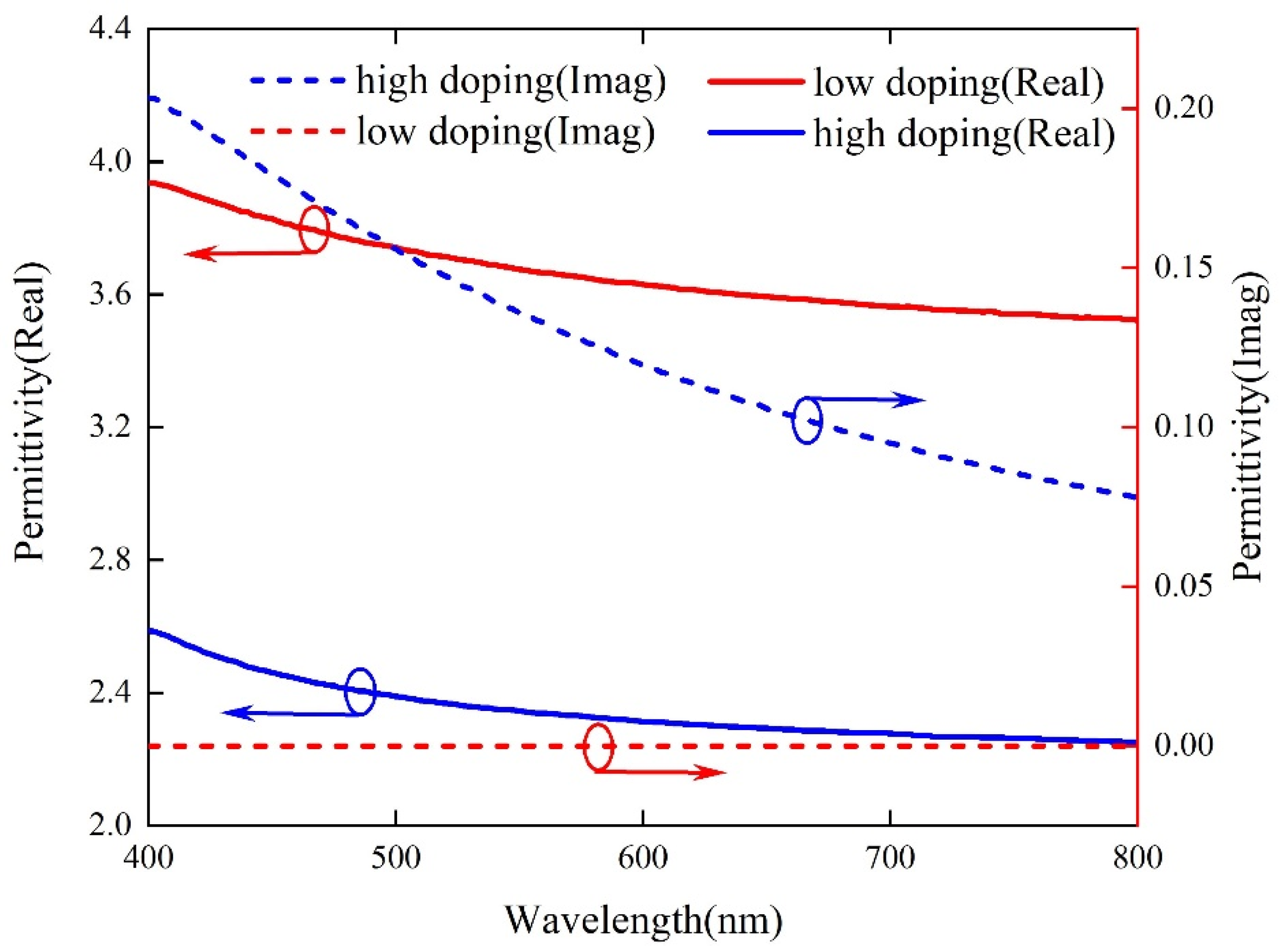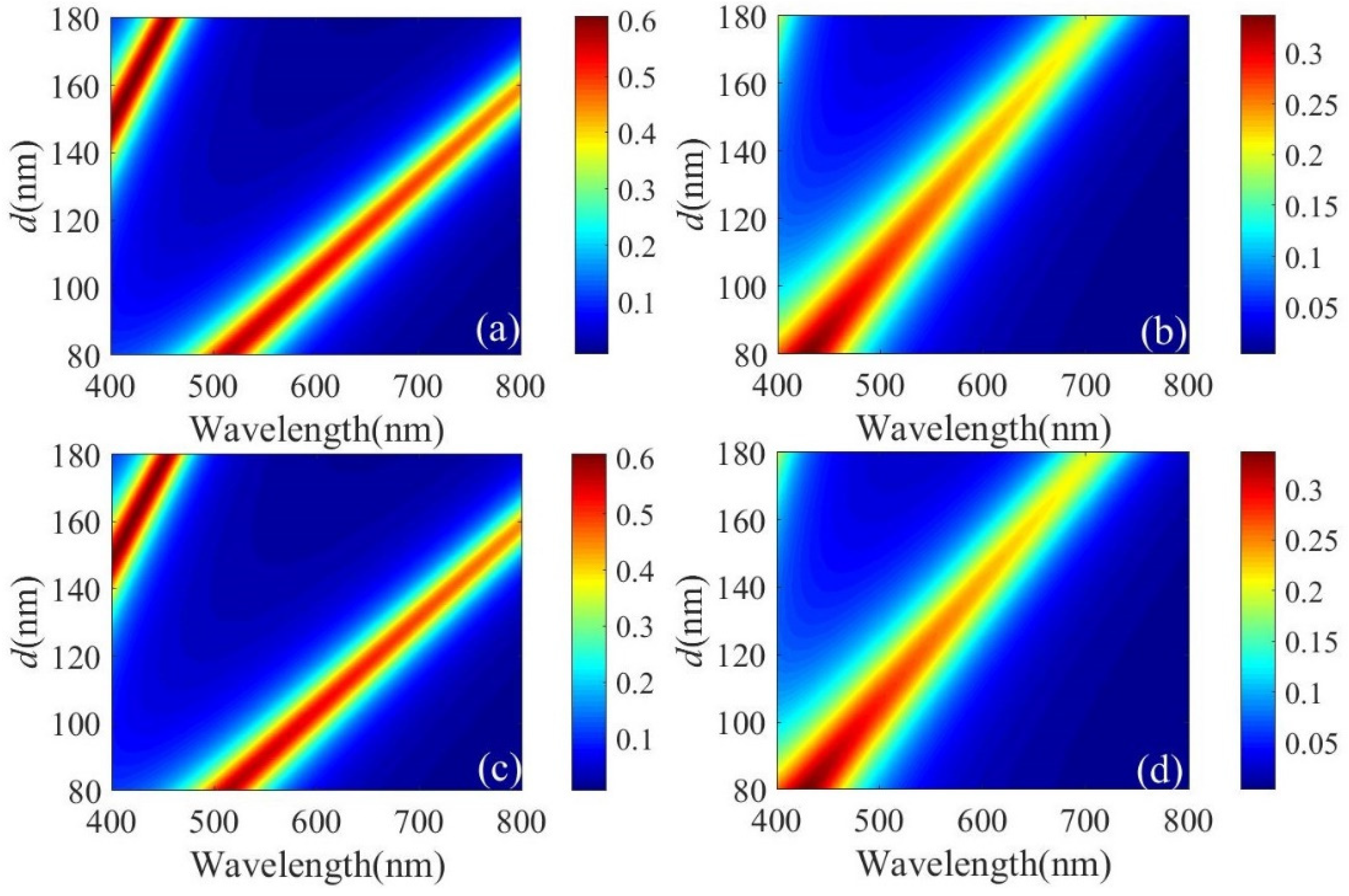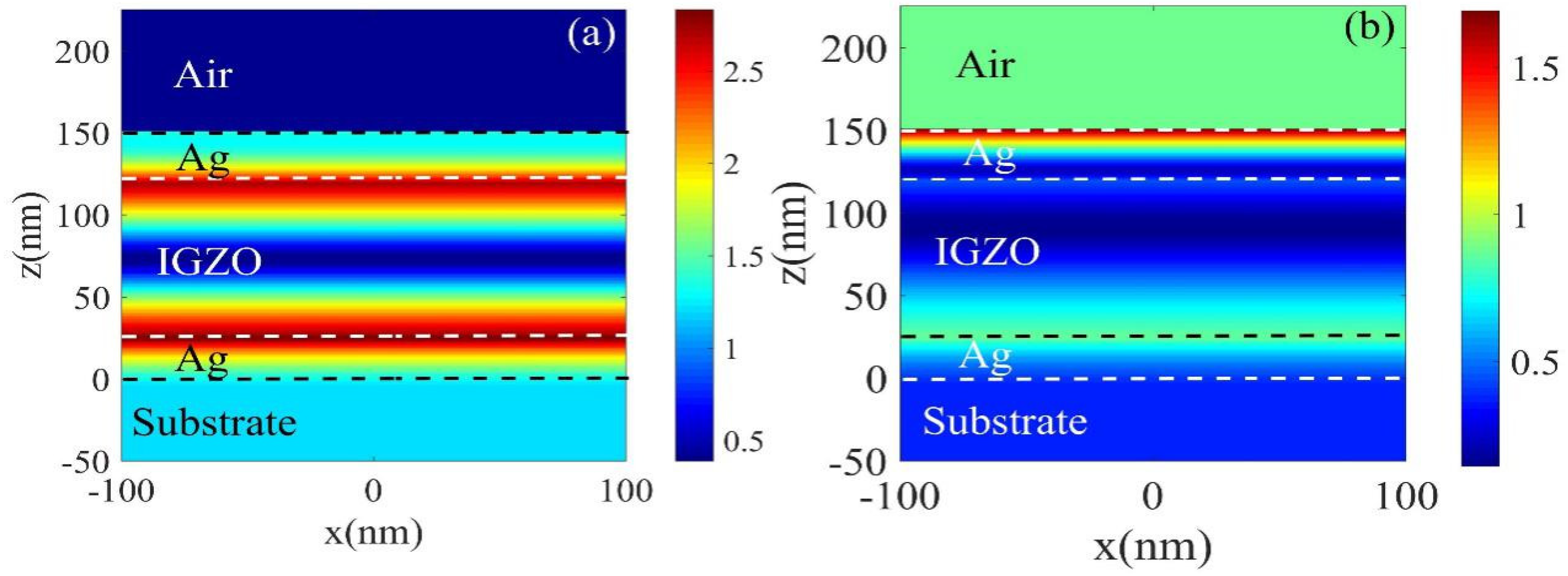Ultra-Thin and Lithography-Free Transmissive Color Filter Based on Doped Indium Gallium Zinc Oxide with High Performance
Abstract
:1. Introduction
2. Model and Methods
3. Results and Discussions
4. Conclusions
Author Contributions
Funding
Data Availability Statement
Acknowledgments
Conflicts of Interest
References
- Tan, S.J.; Zhang, L.; Zhu, D.; Goh, X.M.; Wang, Y.M.; Kumar, K.; Qiu, C.W.; Yang, J.K.W. Plasmonic color palettes for photorealistic printing with aluminum nanostructures. Nano Lett. 2014, 14, 4023–4029. [Google Scholar] [CrossRef] [PubMed]
- James, T.D.; Mulvaney, P.; Roberts, A. The plasmonic pixel: Large area, wide gamut color reproduction using aluminum nanostructures. Nano Lett. 2016, 16, 3817–3823. [Google Scholar] [CrossRef] [PubMed]
- Flauraud, V.; Reyes, M.; Paniagua-Domínguez, R.; Kuznetsov, A.I.; Brugger, J. Silicon nanostructures for bright field full color prints. ACS Photonics 2017, 4, 1913–1919. [Google Scholar] [CrossRef]
- Duan, X.; Kamin, S.; Liu, N. Dynamic plasmonic colour display. Nat. Commun. 2017, 8, 14606. [Google Scholar] [CrossRef] [PubMed] [Green Version]
- Franklin, D.; Frank, R.; Wu, S.T.; Chanda, D. Actively addressed single pixel full-colour plasmonic display. Nat. Commun. 2017, 8, 15209. [Google Scholar] [CrossRef] [PubMed]
- Kristensen, A.; Yang, J.K.W.; Bozhevolnyi, S.I.; Link, S.; Nordlander, P.; Halas, N.J.; Asger Mortensen, N. Plasmonic colour generation. Nat. Rev. Mater. 2016, 2, 16088. [Google Scholar] [CrossRef]
- Montelongo, Y.; Yetisen, A.K.; Butt, H.; Yun, S.H. Reconfigurable optical assembly of nanostructures. Nat. Commun. 2016, 7, 12002. [Google Scholar] [CrossRef]
- Wang, Y.M.; Tian, X.T.; Zhang, H.; Yang, Z.R.; Yin, X.B. Anticounterfeiting quick response code with emission color of invisible metal-organic frameworks as encoding information. ACS Appl. Mater. Interfaces 2018, 10, 22445–22452. [Google Scholar] [CrossRef]
- Xu, T.; Wu, Y.K.; Luo, X.; Guo, L.J. Plasmonic nanoresonators for high-resolution colour filtering and spectral imaging. Nat. Commun. 2010, 1, 59. [Google Scholar] [CrossRef]
- Heydari, E.; Sperling, J.R.; Neale, S.L.; Clark, A.W. Plasmonic color filters as dual-state nanopixels for high-density microimage encoding. Adv. Funct. Mater. 2017, 27, 1701866. [Google Scholar] [CrossRef]
- Lee, K.T.; Han, S.Y.; Park, H.J. Omnidirectional flexible transmissive structural colors with high-color-purity and high-efficiency exploiting multicavity resonances. Adv. Opt. Mater. 2017, 5, 1700284. [Google Scholar] [CrossRef]
- Wan, W.Q.; Luo, M.H.; Liu, Z.M.; Su, Y.F. Ultrathin high-efficiency, variable-color filters with an adjustable bandwidth by combining a cavity resonator and a dielectric film. Opt. Commun. 2020, 459, 124884. [Google Scholar] [CrossRef]
- Tseng, M.L.; Yang, J.; Semmlinger, M.; Zhang, C.; Nordlander, P.; Halas, N.J. Two-dimensional active tuning of an aluminum plasmonic array for full-spectrum response. Nano Lett. 2017, 17, 6034. [Google Scholar] [CrossRef] [PubMed]
- Roberts, A.S.; Pors, A.; Albrektsen, O.; Bozhevolnyi, S.I. Subwavelength plasmonic color printing protected for ambient use. Nano Lett. 2014, 14, 783–787. [Google Scholar] [CrossRef] [PubMed]
- Wang, C.T.; Hou, H.H.; Chang, P.C.; Li, C.C.; Jau, H.C.; Hung, Y.J.; Lin, T.H. Full-color reflectance-tunable filter based on liquid crystal cladded guided-mode resonant grating. Opt. Express 2016, 24, 22892. [Google Scholar] [CrossRef] [PubMed]
- Uddin, M.J.; Khaleque, T.; Magnusson, R. Guided-mode resonant polarization- controlled tunable color filters. Opt. Express 2014, 22, 12307–12315. [Google Scholar] [CrossRef] [PubMed]
- Park, C.S.; Koirala, I.; Gao, S.; Shrestha, V.R.; Lee, S.S.; Choi, D.Y. Structural color filters based on an all-dielectric metasurface exploiting silicon-rich silicon nitride nanodisks. Opt. Express 2019, 27, 667–679. [Google Scholar] [CrossRef]
- Sun, S.; Yang, W.H.; Zhang, C.; Jing, J.X.; Gao, Y.S.; Yu, X.Y.; Song, Q.H.; Xiao, S.M. Real-time tunable colors from microfluidic reconfigurable all-dielectric metasurfaces. ACS Nano 2018, 12, 2151. [Google Scholar] [CrossRef]
- Dong, Z.G.; Ho, J.F.; Yu, Y.F.; Fu, Y.H.; Paniagua-Dominguez, R.; Wang, S.H.; Kuznetsov, A.I.; Yang, J.K.W. Printing beyond sRGB color gamut by mimicking Silicon nanostructures in free-space. Nano Lett. 2017, 17, 7620. [Google Scholar] [CrossRef]
- Chen, M.; Wen, L.; Pan, D.; Cumming, D.R.; Yang, X.; Chen, Q. Full-color nanorouter for high-resolution imaging. Nanoscale 2021, 13, 13024–13029. [Google Scholar] [CrossRef]
- Chen, Y.Q.; Duan, X.Y.; Matuschek, M.; Zhou, Y.M.; Neubrech, F.; Duan, H.G.; Liu, N. Dynamic color displays using stepwise cavity resonators. Nano Lett. 2017, 17, 5555. [Google Scholar] [CrossRef] [PubMed] [Green Version]
- Jung, Y.; Jung, H.; Choi, H.; Lee, H. Polarization selective color filter based on plasmonic nanograting embedded etalon structures. Nano Lett. 2020, 20, 6344–6350. [Google Scholar] [CrossRef]
- Lee, H.E.; Ahn, H.Y.; Mun, J.; Lee, Y.Y.; Kim, M.; Cho, N.H.; Chang, K.; Kim, W.S.; Rho, J.; Nam, K.T. Amino-acid- and peptide-directed synthesis of chiral plasmonic gold nanoparticles. Nature 2018, 556, 360–365. [Google Scholar] [CrossRef] [PubMed]
- Kim, M.; Kim, I.; Jang, J.; Lee, D.; Nam, K.T.; Rho, J. Active color control in a metasurface by polarization rotation. Appl. Sci. 2018, 8, 982. [Google Scholar] [CrossRef] [Green Version]
- Jang, J.; Jeong, H.; Hu, G.; Qiu, C.W.; Nam, K.T.; Rho, J. Tunable metasurfaces: Kerker-conditioned dynamics cryptographic nanoprints. Adv. Opt. Mater. 2019, 7, 1970016. [Google Scholar] [CrossRef] [Green Version]
- Raeis-Hosseini, N.; Lim, S.; Hwang, H.; Rho, J. Reliable Ge2Sb2Te5-integrated high-density nanoscale conductive bridge random access memory using facile nitrogen-doping strategy. Adv. Electron. Mater. 2018, 4, 1800360. [Google Scholar] [CrossRef]
- Hosseini, P.; Wright, C.D.; Bhaskaran, H. An optoelectronic framework enabled by low-dimensional phase-change films. Nature 2014, 511, 206–211. [Google Scholar] [CrossRef] [Green Version]
- Hopmann, E.; Elezzabi, A.Y. Plasmochromic nanocavity dynamic light color switching. Nano Lett. 2020, 20, 1876–1882. [Google Scholar] [CrossRef]
- Yoon, G.; So, S.; Kim, M.; Mun, J.; Ma, R.M.; Rho, J. Electrically tunable metasurface perfect absorber for infrared frequencies. Nano Converg. 2017, 4, 36. [Google Scholar] [CrossRef]
- Yu, Y.L.; Yu, Y.F.; Huang, L.J.; Peng, H.W.; Xiong, L.W.; Cao, L.Y. Giant gating tunability of optical refractive index in transition metal dichalcogenide monolayers. Nano Lett. 2017, 17, 3613–3618. [Google Scholar] [CrossRef]
- Zhu, Y.; He, Y.L.; Jiang, S.S.; Zhu, L.; Chen, C.S.; Wan, Q. Indium-gallium-zinc-oxide thin-film transistors: Materials, devices, and applications. J. Semicond. 2021, 42, 031101. [Google Scholar] [CrossRef]
- Huang, C.Y.; Peng, T.Y.; Hsieh, W.T. Realization of a self-powered InGaZnO MSM UV photodetector using localized surface fluorine plasma treatment. ACS Appl. Electron. Mater. 2020, 2, 2976–2983. [Google Scholar] [CrossRef]
- Peng, T.Y.; Huang, C.Y. Increasing the gas response of ozone sensors based on solution-processed InGaZnO by tuning the size of the nanostructure. ECS J. Solid State Sci. Technol. 2022, 11, 067001. [Google Scholar]
- Kamiya, T.; Nomura, K.; Hosono, H. Present status of amorphous In-Ga-Zn-O thin-film transistors. Sci. Technol. Adv. Mater. 2010, 11, 044305. [Google Scholar] [CrossRef] [PubMed]
- Fujiwara, H.; Kondo, M. Effects of carrier concentration on the dielectric function of ZnO: Ga and In2O3: Sn studied by spectroscopic ellipsometry: Analysis of free-carrier and band-edge absorption. Phys. Rev. B 2005, 71, 075109. [Google Scholar] [CrossRef]
- Li, X.D.; Chen, S.; Chen, T.P.; Liu, Y. Thickness dependence of optical properties of amorphous indium gallium zinc oxide thin films: Effects of free-electrons and quantum confinement. ECS Solid State Lett. 2015, 4, 29–32. [Google Scholar] [CrossRef]
- Kim, I.; Yun, J.; Badloe, T.; Park, H.; Seo, T.; Yang, Y.; Kim, J.; Chung, Y.; Rho, J. Structural color switching with a doped indium-gallium-zinc-oxide semiconductor. Photon. Res. 2020, 8, 1409–1415. [Google Scholar] [CrossRef]
- Lee, K.T.; Han, S.Y.; Li, Z.J.; Baac, H.W.; Park, H.J. Flexible high-color-purity structural color filters based on a higher-order optical resonance suppression. Sci. Rep. 2019, 9, 14917. [Google Scholar] [CrossRef] [Green Version]
- Neuner, B.; Korobkin, D.; Fietz, C.; Carole, D.; Ferro, G.; Shvets, G. Critically coupled surface phonon-polarition excitation in silicon carbide. Opt. Lett. 2009, 34, 2667–2669. [Google Scholar] [CrossRef]








Publisher’s Note: MDPI stays neutral with regard to jurisdictional claims in published maps and institutional affiliations. |
© 2022 by the authors. Licensee MDPI, Basel, Switzerland. This article is an open access article distributed under the terms and conditions of the Creative Commons Attribution (CC BY) license (https://creativecommons.org/licenses/by/4.0/).
Share and Cite
Fan, X.; Wang, S.; Xu, D.; Zheng, G. Ultra-Thin and Lithography-Free Transmissive Color Filter Based on Doped Indium Gallium Zinc Oxide with High Performance. Micromachines 2022, 13, 1228. https://doi.org/10.3390/mi13081228
Fan X, Wang S, Xu D, Zheng G. Ultra-Thin and Lithography-Free Transmissive Color Filter Based on Doped Indium Gallium Zinc Oxide with High Performance. Micromachines. 2022; 13(8):1228. https://doi.org/10.3390/mi13081228
Chicago/Turabian StyleFan, Xiangrui, Shengyao Wang, Dongdong Xu, and Gaige Zheng. 2022. "Ultra-Thin and Lithography-Free Transmissive Color Filter Based on Doped Indium Gallium Zinc Oxide with High Performance" Micromachines 13, no. 8: 1228. https://doi.org/10.3390/mi13081228
APA StyleFan, X., Wang, S., Xu, D., & Zheng, G. (2022). Ultra-Thin and Lithography-Free Transmissive Color Filter Based on Doped Indium Gallium Zinc Oxide with High Performance. Micromachines, 13(8), 1228. https://doi.org/10.3390/mi13081228




